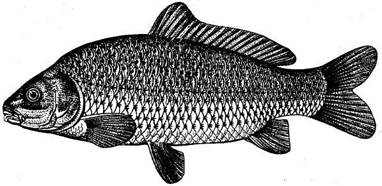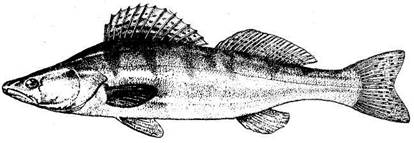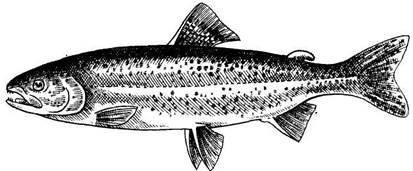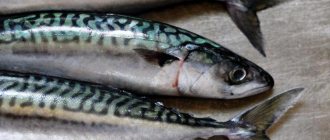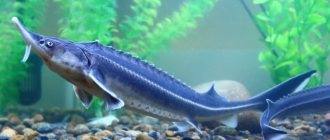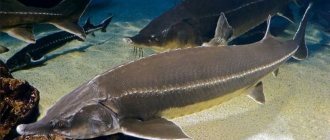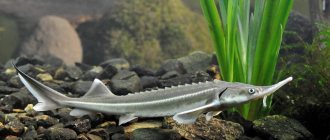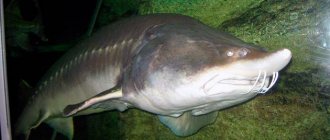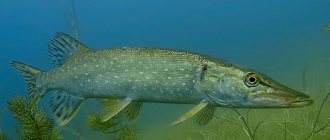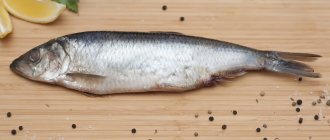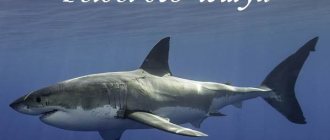Carp fish belongs to the class of ray-finned fish, which are distinguished by a variety of species and large sizes. In Russia and the CIS countries there are about 130 species of cyprinids, distinguished by their impressive size and different habits. In addition to wild ones, there are varieties bred artificially.
Are you preparing carp fish?
- Yes 83%, 2435 votes
2435 votes 83%2435 votes - 83% of all votes
- No 9%, 252 votes
252 votes 9%
252 votes - 9% of all votes
- I will cook according to your recipes 4%, 130 votes
130 votes 4%
130 votes - 4% of all votes
- I don't eat fish 3%, 101 votes
101 votes 3%
101 votes - 3% of all votes
Total votes: 2918
26.06.2020
×
You or from your IP have already voted.
Carp: description, structure, characteristics. What does carp look like?
Golden carp is a fairly large fish of brown or yellow-green color. However, carp, depending on their habitat, may have other colors. The body of the carp is elongated and covered with golden scales, although there are also species of carp without scales.
The carp's head is large and its mouth is retractable. The dorsal fin is quite long and also has a small notch, while the anal fin of the carp is, on the contrary, short. Both fins have a jagged, spiny ray. The sides of the fish are usually golden in color and the back is dark.
Lifestyle Features
Despite its impressive size, carp requires special conditions of detention. And only then will the fish grow and multiply quickly.
Habitats
Carp loves warm water, so it chooses mainly practically stagnant bodies of water: lakes, ponds, rivers with a small current and depth. This is an ideal place to live.
Also, carp does not tolerate direct sunlight, so the reservoir should be quite shady; a river with a forest along its banks is ideal.
Carps can be found from northern Russia to Asia. This fish will live wherever there are suitable conditions.
Carps have also chosen the warm shores of the Kingdom of Thailand. There are individual species here that are distinguished by their outstanding size and color.
The warm and humid climate is ideal for fish to live and actively reproduce. But these giants are found only in fresh water. And there are very few such reservoirs in the sunny country.
Nutrition
If carp is raised in a special private pond, it eats food that is provided to it by humans. However, if it grows in natural conditions, then it chooses a varied menu for itself.
It digests plants well and can feast on insects that find themselves on the surface of the water.
Carp is very fond of worms and mollusks that live on the bottom. In Asian countries they will not refuse shrimp, mussels, and larvae.
Predator or not
Carp cannot be called a predator, since it does not feed on other fish, much less humans. However, it is quite difficult to exist with him in the same area.
Some subspecies behave quite quietly and withdrawn. Others, more active, can organize real battles for territory, so individual inhabitants of the reservoir can be seriously harmed.
How long does he live?
The lifespan of carp depends on the conditions of detention. If all the necessary conditions are created in a private pond, she will live well for up to 20 years.
In their natural environment in warm ponds, some species can live up to 50 years.
Does pike eat carp?
Pike is a predatory fish, dangerous to many inhabitants of fresh water bodies. However, even this predator is unable to cope with an adult carp, which is of impressive size, so the pike prefers not to compete with such a giant and avoids it.
However, this predator can be dangerous for small carp under the age of two years. In size, they are exactly like perch, which pike can easily profit from, so it is better for the fry to stay in a school protected by larger individuals.
How does one gain weight?
Carp begin to rapidly gain weight at the age of 2 years. As a rule, in the natural environment everything happens simply. With age, the carp's body increases in size and the need for more protein appears. It can be easily replenished with the help of mollusks, worms, and larvae.
If we are talking about carp that are raised in private ponds, their weight can be artificially adjusted by humans. To do this, carp are offered food that is rich in protein. They start giving it at 6 months.
Carp quickly gain weight and can reach 5 kg in a year.
Reproduction and spawning
Like many other fish, carp are heterosexual. The reproductive organs mature by the first year of life, and maturity occurs by one and a half years. From the age of 2 years, the fish goes to spawn.
Ideal conditions for reproduction are water temperatures of at least 18 degrees. In private ponds, carp are planted for spawning in special cells that were created for these needs.
Two males are allowed into one female to ensure fertilization occurs. The fish spend about 10 hours together, after which they are released. The fertilized female quickly moves to the pontoon and after some time begins to spawn. Males are called upon to protect their offspring from various factors.
Fertilization in carp is carried out externally. Fertilized eggs develop up to 5 days, depending on environmental conditions.
What is the difference between a female and a male
The female and male differ in body size. Females are much more impressive in size. Upon careful examination, the male and female can be distinguished from each other.
Some types of carp allow you to distinguish individuals due to the special color that is inherent in females or males.
Differences between the sexes can also manifest themselves in behavior. For example, at the time of spawning, females are more warlike. But when the eggs are laid and need to be protected, the males begin to be aggressive towards everything that comes close to the future offspring.
At what age does it begin to spawn?
Carp begin to spawn at the age of 3 years. From one year on, nothing prevents him from going to spawn. However, at this age, fertilization occurs extremely rarely.
Where do carp live?
Carps live in almost all freshwater bodies of Europe, Asia, and North America. But since this fish is very thermophilic, it is not found in the north of Europe, Asia and America, but there are plenty of carp living in the temperate zone.
As habitats, these fish prefer large lakes and deep rivers with a slow flow and a moderately silted bottom.

Habitats
Carp: Lives in deep ponds and lakes of standing water resources. Spends time at great depths and at the very bottom, where there is an abundance of plant life. Withstands lack of oxygen. Loves rainy weather, active when there is wind. Caught in the early morning hours.
It bites on bait made from potatoes, corn and peas. However, one should not forget one characteristic: over the course of a whole day, carp can change their attitude towards groundbait and bait. They should be alternated, otherwise you may waste the day and return home without a catch.
Carp: Activated in water with a temperature of +25 degrees. The heat-loving individual quickly gains height and weight. It is easy to find in water resources where there is a strong seething current and a good supply of oxygen. It often lives in flowing lakes. If the rivers are in the southern part, then you can always find carp without much effort.
Ideal places are edges near steep banks. In addition, carp loves places where the shore abruptly ends and the depth appears. This individual is caught in the evening and at night. Fish loves to hunt in overgrown backwaters, you can take advantage of this. During the daytime it prefers to be at depth.
What does carp eat?
During their life, carp are capable of gaining weight up to 50 kg, and such a large growth is facilitated by both the omnivorous nature of this fish and the special “stomachless” structure of their digestive system, that is, in favorable conditions, the carp eats almost “non-stop”. This feature of this fish sometimes makes us jokingly compare carp to pigs; experienced fishermen know very well that carps constantly rummage in the mud in search of food, just like pigs rummage in the mud. This is not to the benefit of the carp themselves, since with this behavior they betray their presence with large (about 10 cm in diameter) bubbles.
As for the food that carp eat, these include crustaceans, microorganisms, tadpoles and toads, and even fry of their own species (yes, carp have cannibalism). Moreover, smaller carp flock into schools for successful hunting, while older individuals prefer to lead a solitary lifestyle.
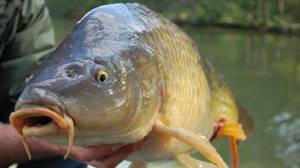
Morphology and anatomy of carp
1>
BIOLOGICAL FEATURES OF FISH
The biological characteristics of farmed fish are the basis on which the entire technology for obtaining marketable products in fish farming is built, the use of all kinds of intensification measures, devices, and mechanisms. The biology of fish differs significantly from the biology of ordinary farm animals due to their different systematic position in the animal world and different habitats. Different species of fish are bred in pond farms, the main life manifestations of which can vary significantly. Therefore, students should know the biological characteristics of the main fish species currently used in fish farms in our country.
Pond fish
Carp - Cyprinus carpio, L. (Fig. 1)
- a large fish that lives in the rivers of the Black and Caspian Seas and the Pacific Ocean. It is also found in Lake Balkhash. The weight of individual individuals can reach 20 kg. The body is purulent, ridge-shaped, yellow in color in the Amur carp - greenish, covered with large scales. Each scale has a dark spot at the base and is bordered by a black stripe along the rear edge. The ratio of fish body height and length is 1:3 -1:4. The first ray of the dorsal and anal fins has serrations. There are 2 pairs of antennae on the upper lip at the corners of the mouth. The mouth is lower, retractable. The pharyngeal teeth are three-row, chewing type.
Carp is a heat-loving fish. It can live not only in fresh water, but also in brackish water. It grows normally at a salinity of 10 (ppm), but reproduces in water with a salinity of no more than 2 -3‰. In the Volga-Caspian and Caspian-Kura regions, a distinction is made between sea, pit and river carp. Sea carp is found in brackish and salt waters. In the summer, the Yamna fish stays in brackish waters, and in the winter it enters the pre-estuary areas of rivers, where it spends the winter in pits. The sea carp lives in rivers and lakes and is smaller in size than the sea and pit carp.
Due to its high nutritional qualities and good growth rate, carp have been acclimatized in many water bodies of the country, including Siberia. Sexual maturity occurs in the 3-5th year of life. Fertility varies depending on the mass from 96 to 1600 thousand eggs. Carp spawns from late April to early August, depending on the climatic conditions of the geographical area, at temperatures above 18°C, but there is carp, for example, from Lake Taparavan, which spawns at 12-14°C, and in the reservoirs of Tatarstan - at 15 °C.
|
| Fig.1. Amur carp ( Cyprinus carpio, L.) . |
For spawning, carp choose areas of reservoirs with shallow depths, well-warmed, with stagnant or low-flowing water and rich vegetation. The caviar of the carp is small, sticky, and is swept onto the vegetation. Under optimal conditions, the development of eggs lasts 4-5 days. After hatching, the larvae are inactive for about a day and attach to the vegetation using a sticky gland located on the head. They have a length of 4.2-4.4 mm and a weight of 1-2 mg.
For the first few days, the larvae live off the yolk sac (the remains of the egg yolk), then they begin to capture small forms of zooplankton. They completely switch to external feeding 3-6 days after hatching.
In the first half of summer, the fry feed on zooplankton, then gradually switch to feeding on bottom organisms - benthos (insect larvae, worms, etc.) The diet of adult carp contains weed seeds, algae, and higher aquatic plants. The carp grows quickly and by the end of the first summer reaches a weight of 35-70 g, and by the end of the second summer - 300 - 400 g or more.
In the autumn, the carp gradually refuses food, gathers in large flocks and stays in the deep parts of the reservoir, being in a sedentary state. During the winter period, it loses weight up to 10% or more.
Carp is one of the most important breeding objects in lake commercial farms. It is also used in pond farms, especially in those areas where carp gives worse results. Carp is also used in breeding work to create new breeds of carp. Thus, the Sarboyan carp, created for the conditions of Western Siberia, was obtained with the infusion of blood from the Amur carp. Carp from the Taparavan lakes participated in the creation of the Ropshin breed group.
Carp is highly resistant to adverse conditions. It is winter-hardy and resistant to some infectious diseases, in particular, carp rubella.
Carp meat contains up to 6.5% fat and 16.14% protein. The yield of edible parts is 54.4%, calorie content is 878.5 kcal/kg.
Carp (Fig. 2
) – a cultivated form of carp. In contrast, carp have a taller body, faster growth and better feed efficiency.
The head is small. The back is dark green, the sides are yellowish, the fins are gray, and the lower edges of the caudal and ventral fins are reddish. As a result of centuries-old selection, the scaly cover of carp varies from complete to almost complete absence. Mouth with thick lips, retractable. There are 2 pairs of antennae at the corners of the mouth.
| Fig.2. Types of scaly cover of carp: a – scaly, b – mirror, c – framed, d – naked. |
Carp is a freshwater fish, but can live in water salinities of up to 9–10‰. For reproduction, water salinity should not exceed 2‰. Prefers low-flow and stagnant bodies of water. Adult carp are cautious and timid, but quickly get used to humans. He easily develops various conditioned reflexes: to the time and place of feeding, sound, etc.
Puberty occurs in Siberia at the 4-5th year of life, in the southern regions - 1-2 years earlier. Males mature a year earlier than females. The fertility of carp is high. Relative fertility is 180 thousand eggs per 1 kg of weight.
Spawning occurs in stagnant water at temperatures above 17°C, but is also observed at lower temperatures. Females lay eggs on freshly watered vegetation. The development of eggs lasts 3-6 days, and sometimes more. From the 2nd day of life, hatched larvae switch to feeding on protozoa, rotifers, and young crustaceans. The larvae switch completely to external nutrition on the 4th-6th day of life. The transition to benthic nutrition in juveniles occurs gradually and is completed at the end of the first summer of life. From the second summer, the main food of carp is benthos, but large forms of zooplankton are readily eaten by them. In pond farms, it consumes human feed well. This gives grounds to talk about the omnivorous nature of carp, although it grows especially quickly on food of animal origin.
Under optimal conditions, in the first summer, carp can reach a weight of 400-800 g or more, and in the second summer - over 1 kg. In full-system pond farms and fish hatcheries, to obtain a large number of fish per unit area, fingerlings are grown up to 25-30 g, and two-year-olds - up to 400-500 g. In pool farms on warm waters, carp reaches 600-700 g in 6-8 months Carp live for quite a long time, according to some sources up to 50 years, and can grow up to 50 kg. In fish farms, mature carp usually weigh 3.5-10 kg, so they are kept for up to 10-14 years.
Currently, carp is the most common pond fish not only in our country, but also in the world. It accounts for about 50% of global fish production in fish farms.
Based on their scaly cover, the following types of carp are distinguished: scaly and mirror (scattered, linear, naked or leathery). Based on body shape, carp are divided into high-back and broad-back. This determines their meat quality (yield of edible parts).
Currently, the following carp breeds are approved in our country.
Sarboyan carp (authors of the breed: Korovin V.A. and Zybin A.S.). The first Siberian breed, approved in 1987. Bred in Western Siberia. Currently, it has proven itself well in other regions of the country. Belongs to the group of broad-backed carp. The ratio of height to length is 1:2.5-1:2.75. Head length no more than 1/5 body length. The scaly cover is continuous. It is distinguished by high fertility - 80-310 thousand larvae during natural spawning and more than 475 thousand during hatchery spawning.
Winter hardiness is high - no less than 94.5%. Spawning is observed even at temperatures below 16°C. Resistant to oxygen deficiency. During the short Siberian summer it is able to reach a standard weight, both at the fingerling and two-year stages. Pays well for growth with feed added to the water. Sarboyan carp has an admixture of blood from Amur carp and Ropsha carp. Currently, the breed has 3 types (layering): northern, Omsk and steppe.
Parsky carp (created by the team of authors Bobrova Yu.P., Voronkova E.B., Elufimova L.A., Golovinskaya K.A., Shchelokova P.M., Timirov N.T., Lavrukhina S.I., Garin A. .G., Polyansky A.A.). Approved as a breed in 1989. Designed for the Central and Central Black Earth zones. It has 2 breedings: local ones with a continuous scaly cover and carp descended from Ukrainian and local carps with scattered scaly cover. Local carps were obtained by crossing outbred carp with Amur carp. They have better winter hardiness. The second layer has a higher growth rate. The fertility of Parsi carp is high - 300-350 thousand eggs per female. The yield of larvae from a female during hatchery reproduction is 150-175 thousand, during natural spawning - 70-120 thousand. The yield of fingerlings is 80%, yearlings -75. The body is runaway. The average weight of females is 8-9 kg.
Altai mirror carp was approved as a breed in 1994. Created by a team of authors - Ivanova Z.A., Moruzi I.V., Sapunov L.Ya., Buymov V.M., Prisyazhnykh V.S., Zhukova L.I., Zhdanova N.I. The breed was obtained through targeted selection of descendants of Galician carp, brought to the Altai region back in 1932. Altai carp have a mirror-type scaly cover. The body is tall. The offspring are distinguished by high winter hardiness - not lower than 95-96%, feed consumption per 1 kg of growth for underyearlings is 2.8, for two-year-olds - 3.1 kg, which is lower than the standard for the second fish-breeding zone. Fertility is high: with hatchery reproduction 442-887 thousand eggs, with natural spawning - 100-110 thousand 7-day-old larvae. It has a good growth rate and early maturity. At the age of three, all males and 80% of females are sexually mature.
Ropshinsky carp is a breed bred under the leadership of Kirpichnikov A.S. Team of authors: Andriyasheva M.A., Babushkin Yu.P., Dyakova G.N., Zonova A.S., Kirpichnikov V.S., Konradt A.G., Petrov B.G., Ponomarenko K.V. , Slutsky E.S., Tishchenko Yu.F., Faktorovich K.A., Chapskaya M.K. . Designed for the North-Western regions of the country. It is characterized by high winter hardiness, which is determined by the large proportion of blood of Amur and Taparavan carp, which are one of the original species of fish that participated in the creation of this breed. Ropshinsky carp grows somewhat slower than pure carp, but is better suited for this region.
In recent years, a lot of work has been done to create new breeds of carp in Russia. To date, 19 breeds have been registered, such as the Angelinsky, Cherepetsky, Stavropol and other breeds. Prepare for testing Central Russian carp.
In the CIS countries there are Belarusian carp and Alma-Ata carp. Particularly noteworthy are Ukrainian carps. These are the first breeds created in the 60s by I.A. Kuzema.
Ukrainian scaly carp belongs to the group of high-backed carp. Fattening type breed. The body is tall, the head is small. The occipital and anal junctions are well developed. The scaly cover is continuous. 40-45% better use of natural food compared to outbred carp. The weight of two-year-olds is 17-18% greater than that of outbreds. The yield of larvae from 1 female is on average 300-600 thousand. Winter-hardy. Sexual maturity in females occurs in the 3rd year of life, in males - in the 2nd. Three-year-olds reach a weight of 3 kg, four-year-olds - 4-6 kg. The yield from wintering ponds is 90-95%.
The Nivchan herd was created on the basis of Ukrainian scaly carp. It was obtained by introductory crossing with Ropsha carp. Nivchan carps have a greenish tint to their scales. They retain early maturity, rapid growth and high fertility, and in addition, they have acquired higher cold resistance and winter hardiness. Well adapted for growing in large river-bed ponds.
Ukrainian framed carp . It is distinguished by a tall body. The scales are large, mirror-like, located in the form of a frame along the edges of the body. Fattening type breed. Spends 21-23% less feed per 1 kg of growth than ordinary carp. The yield of larvae from 1 female is 200-600 thousand. Winter-hardy. The yield of yearlings from wintering ponds is at least 90%. The fish productivity of ponds with framed carp is 25% higher compared to outbred carp.
Grass carp - Ctenopharyngodon idella, Rich.
(Fig. 3). Freshwater fish of the Pacific coast. Successfully acclimatized to many countries in Europe, Asia, and America. The color of the back is greenish or yellowish-gray, the sides are dark golden. The body is purulent, ridge-shaped, covered with large scales. There is a dark rim along the edge of each scale, except for the scales located on the abdomen. The abdomen is light golden. The dorsal and caudal fins are dark, all other fins are lighter. The iris of the eyes is golden.
| Fig.3. Grass carp ( Ctenopharyngodon idella, Rich.) |
Grass carp tolerates a wide range of temperatures and salinity up to 12‰. Withstands short-term oxygen reduction to 0.5 mg/l. Sexual maturity in the Amur River occurs at 8-9 years of age. In Central Asia, male grass carp mature at the age of 3-4 years, in the Krasnodar Territory - at 4-5 years, in the Moscow Region - at 7-8 years, in the Altai Territory - at 9-10 years. The fertility of females ranges from 290 to 816 eggs. Spawning is portioned.
The eggs are floating and develop in the water column. Spawning sites are sections of rivers with a flow of 1-1.7 m/s. The water temperature during the spawning period is 24-30°C. Grass carp does not reproduce in ponds, so its offspring are obtained in a factory manner. The development of eggs at a temperature of 25-27°C lasts 23-30 hours.
Grass carp is more heat-loving than carp. Grows better in the southern regions of the country. In Western Siberia, fingerlings grow up to 15-20 g, two-year-olds – 300-400 g. The fish is hardy and winters well in Siberia.
According to the nature of its feeding, grass carp belongs to the group of herbivorous fish. It switches to feeding on vegetation quite early, at a length of about 3 cm, at the age of 20-22 days. Due to the consumption of plant foods, his pharyngeal teeth are of the chewing type, highly serrated. The intestine is long, three times longer than the body of the fish. It feeds better at temperatures above 20°C. Food consumption is sharply reduced at temperatures below 10-12°C.
Young-of-the-year grass carp eat soft underwater vegetation, and they also consume duckweed. Older fish feed not only on soft underwater vegetation (pondweed, chastukha, urut, hornworts, filamentous algae, etc.), but also on terrestrial vegetation, for example, clover, nettle, alfalfa, quinoa. Large individuals eat young shoots of reeds, cattails, and sedges. For 1 kg of growth, up to 18 kg of vegetation is consumed. In this regard, white carp is an excellent ameliorator. He willingly eats compound feed, but grows worse on it. The rate of passage of food through the intestines is fast, so up to 50% of excrement is undigested food.
The fish is large, reaching a weight of 10 kg or more. Grass carp meat is tender, tasty, and contains 3.5-7% fat. Grass carp is used in polyculture with carp and other fish species. Natural fish productivity for grass carp in ponds in Western Siberia reaches 100 kg/ha, in the southern regions of the country it is much higher.
Silver carp or common carp - Hypophthalmithus molitrix, Val. (Fig. 4).
The fish is freshwater, common in the same reservoirs as grass carp. Widely used in fish farms in many countries around the world. It is distinguished by a large head and thick body. The color is gray, the scales are medium in size. From the throat to the anus there is a leathery fold - the keel. The mouth is large and upper. Lives in the water column. Very shy. When caught, with sharp impacts on the water, it jumps to a considerable height.
|
| Fig.4. Silver carp (Hypophthalmithus molitrix, Val.) |
The onset of puberty depends on climatic conditions. In the Krasnodar Territory it occurs in the 3-4th year, in the Amur River - in the 5-8th year. Spawning occurs at a temperature of 20-30 °C. It spawns in a fast current. The caviar is floating. Fecundity ranges from 250 to 1600 thousand eggs. The incubation period at a temperature of 23-25 ° C is 30-32 hours. Spawning is portioned.
Silver carp feeds on phytoplankton (tiny algae). For this purpose, it has a unique gill apparatus. On the gill arch there are up to 2-3 thousand rakers with processes, forming a kind of sieve through which microalgae measuring 10 microns do not pass. Zooplankton in the diet of silver carp does not exceed 3%. In spring, mostly detritus is found in the food bolus. It switches to feeding on phytoplankton early, at a length of 1.5 cm. The best for silver carp are diatoms and green algae. The daily diet is 17-30% of body weight. The intestines are long, 5-6 times the length of the fish’s body, which contributes to good digestion of food. In ponds it eats dusty particles of feed.
Grows quickly. In Siberia, underyearlings grow up to 15-20 g, in the southern regions - up to 25-30 g or more, two-year-olds 300-350 g, sometimes about 1 kg. The growth rate increases in the 3-4th year of life. The fish is large, reaches 16-40 kg. Meat contains up to 23% fat. Used in polyculture with carp and other fish species. Fish productivity for silver carp in Siberia is 150-200 kg/ha of water area, and in the south it is much more.
Pike - Esox lucius, L. (Fig. 5)
lives in fresh water bodies of Europe, Asia, America. There are five species: common pike (European), Amur, musky, striped and redfin. The last three species live only in North America. The body is elongated, arrow-shaped, completely covered with scales. The head is greatly elongated, the lower jaw protrudes forward.
| Fig.5. Pike (Esox lucius, L.) |
The mouth is large, with numerous teeth used to hold food. Color ranges from light gray to dark green, depending on the body of water. Some fish have transverse stripes on their sides. Amur pike has smaller scales. Adults have bright black and brown spots on the sides of the body. The same spots are present on the dorsal, caudal and anal fins.
Puberty occurs at the 3-4th year of life. Fecundity ranges from 17.5 to 215 thousand eggs, for large individuals - up to 1 million. Spawns in early spring at a water temperature of 3-8 ° C off the coast at a depth of 0.5-1 m and in flood meadows. Small individuals spawn first, then larger ones. Pike caviar is quite large (up to 3 mm), slightly sticky. During spawning, 2-4 males gather around the female, and up to 8 males around large ones. Males are always smaller than females.
It lays eggs on last year's vegetation. After 2-3 days, the stickiness disappears and the eggs develop at the bottom of the reservoir. The general incubation period is 8-14 days. The length of the larva is 6.7-7.6 mm. Up to 8-10 days the larva feeds on the yolk sac, and up to 18-20 days on zooplankton. With a length of 12-15 mm, juveniles capture large organisms, including juveniles of other fish species. From 3 weeks of age, pike exhibit cannibalism. From now on, pike landings should be rare.
Pike grows quickly. The optimal temperature for nutrition and growth is 19-20°C. Fledglings reach a weight of 150-200 g or more. The meat is lean, contains 18-19% protein, and only 0.5% fat. They are unpretentious to food and eat not only juveniles of other fish species, but also many large invertebrates, tadpoles, etc.
Only fingerlings are raised in ponds together with other fish species, in particular carp. In feeding ponds, 3-week-old pike fry are added to yearlings at the rate of 70-300 specimens/ha, with an abundance of low-value fish - up to 400-600 specimens/ha. Natural fish productivity for pike is up to 30-40 kg/ha. Pike offspring are obtained in spawning ponds and in a factory manner.
Pike not only provides valuable products, but is also a good biological ameliorator of our water bodies. When pike and carp are reared together, the natural fish productivity of carp increases by 60 kg/ha due to the destruction of its food competitors by the pike.
Pike perch - Lucioperca lucioperca, L. (Fig. 6)
lives in reservoirs of the European part of the country. In Siberia it is acclimatized in some lakes and reservoirs. The fish are schooling, but large individuals live alone. The body is elongated, laterally compressed, covered with tightly attached small scales. The body shape is torpedo-shaped. Has 2 dorsal fins. Part of the gill cover is covered with scales. The mouth is large, jaws with numerous teeth. The back has a greenish-gray color. There are a number of dark spots on the dorsal and caudal fins. The sides are decorated with brown and black stripes. The fish is large, reaching a length of 130 cm and a weight of 20 kg.
|
| Fig.6. Pike perch ( Lucioperca lucioperca, L.) |
Puberty occurs at the 3-4th year of life. Fertility 82-1185 thousand eggs. Spawns at temperatures 8-120C. Before spawning, pike perch rise to the surface layers and break into pairs. The male is looking for a shallow place for a nest where there are rhizomes. The nest is a hole 4-5 cm deep and 0.5 m in diameter. Artificial nests are built for it in ponds with a muddy bottom. The male cleans the nest of silt and debris. After spawning, it remains at the nest and, with frequent movements of the pectoral fins, drives water onto the laid eggs. The incubation period lasts at a temperature of 9-100C for 10-11 days, and at a temperature of 18-210C for 3-4 days. The first 2-3 days the larvae do not leave the nest. After 6-7 days they begin active feeding. They switch to feeding on juveniles of other fish species early, at the age of 1 month.
Grows quickly. In the 1st year it reaches 10-15 g, in the 2nd – 300-400. Grows best at temperatures of 15-180C. It also feeds in winter. Winters well in ordinary carp wintering ponds.
Used as supplementary fish in ponds. For joint cultivation, choose not overgrown, slightly silted ponds. Pike perch is demanding on the oxygen regime. Yearlings of pike perch are planted in feeding ponds where there is low-value fish at the rate of 200-300 specimens/ha. Thanks to pike perch, you can get an additional 20-30 kg/ha. At the same time, the natural fish productivity of carp increases.
Pike perch meat contains 17.7% protein and 3% fat.
Trout - Oncorchynchus mykiss, W. (Fig. 7)
lives in fast rivers of the North Caucasus, Western Ukraine, and the Baltic states. It is also found in some mountain lakes. This is the main object of cold-water farming. There are 2 forms of trout: brook and rainbow. Brook trout has many red and dark spots with light rims on its body, for which it is sometimes called the damselfish. Rainbow trout have colored stripes on their sides, which are especially pronounced during the spawning period. The body is torpedo-shaped. The color is gray, the scales are small.
|
| Fig.7. Trout |
Puberty occurs at the 3-4th year of life. In biology, the rainbow and stream forms differ from each other.
Fertility in brook trout is 1.5-2.5 thousand eggs per female. The caviar is large, not sticky. It spawns in the fall from the end of September, burying eggs in pebbles, where they develop throughout the winter. The yolk sac resolves after 18-20 days. In pond farms, a factory method of producing offspring is organized.
Rainbow trout spawn in March. Fertility 2-3 thousand eggs. At a temperature of 10°C, the incubation period lasts 30-35 days. Juveniles feed on zooplankton, then switch to feeding on invertebrates living in the water column. Both forms of trout feed in the water column and practically do not take food from the bottom. In fish farms, trout are fed with special compound feeds, the main share of which is animal feed. Rainbow trout grows faster than brook trout: in the 1st year it reaches a weight of 25-30 g, in the 2nd year – 170-250. In our country, only rainbow trout are bred. Brook trout in the 1st year of life grows to 15-20 g, in the 2nd year – up to 125-175. Rainbow trout is less demanding of habitat conditions than brook trout, so it can be used as an additional fish in carp feeding ponds. It can withstand short-term temperature increases up to 300C. It grows faster in ponds than in rivers. However, ponds that have deep-water areas that are not overgrown or silted, preferably slightly flowing, are suitable for its cultivation. In specialized trout farms, the fish productivity of ponds with intensive technologies can be more than 50 t/ha.
Yearlings of trout are planted in carp ponds at a rate of 200-300 specimens/ha. Breeding work is being carried out with trout, as with carp; to date, a breed of rainbow trout has been developed in our country - the Adler trout.
Peled (cheese) Coregonus peled, G.
- lake and river fish that lives in reservoirs in the north of the country, mainly in the Siberian north. There are several forms: river, lake, large, dwarf. The lakes and rivers of the Ob North are the main base for peled fishing. The mouth is terminal, the upper jaw is slightly longer than the lower jaw. The body is tall and elongated. The color is dark gray. The scales are medium, not firmly attached. Behind the dorsal fin is an adipose fin, a distinctive feature of all whitefish and salmon.
|
| Fig.8. Peled (Coregonus peled, G.) |
Sexual maturity occurs at 3-5 years of age, in pond farms 1-2 years earlier. Males and females are easy to distinguish during the spawning period. Males develop nuptial plumage in the form of epithelial tubercles on the body of the fish. The fish becomes rough to the touch. When light pressure is applied to the abdomen, droplets of milk are released.
The fertility of peled is 25-105 thousand eggs. Dwarf forms have much less. Spawns in the fall in October-November and even in December, at a temperature of 1-4°C. The eggs are laid on sandy and pebble soil, and in lakes - on hard soil with plant debris. The water depth at the spawning grounds is 1-3 m. Eggs develop throughout the winter at temperatures below 1°C. The larvae hatch in April-May.
The peled feeds mainly on zooplankton. Benthic organisms appear in the food bolus when there is a lack of zooplankton. Grows quickly. In the 1st year of life it can grow to 70-100 g or more, in the 2nd year - up to 400-500 g. The optimal temperature for growth is 16-18°C. Unlike many salmon fish, peled tolerates a short-term increase in temperature to 22-27°C, while feeding intensively. This allows it to be grown in ordinary carp ponds.
Used as additional fish in carp farms. It has proven itself especially well in lake commercial farms. High quality meat, contains 13% fat. About 80% edible parts. Larvae are planted in ponds and raised to the fingerling stage. Planting rate is 5-10 thousand/ha. Does not tolerate transplants from pond to pond well. To produce two-year-olds, the fingerlings are left to overwinter in the same body of water.
Golden crucian carp - Carasius carasius, L. ( Fig. 9) is distributed everywhere with the exception of the Far East. The body of the golden crucian carp is round, covered with scales. The head is small, the mouth without antennae. The color is golden, even copper. The lateral line is broken. There are 23–32 gill rakers on the first gill arch. The first rays of the dorsal and anal fins are slightly serrated. The pharyngeal teeth are single-rowed.
The fish is very hardy, able to withstand a decrease in oxygen to 0.5 mg/l, - pH to 4.5. In the overseas lakes of Siberia it is often the only representative of the ichthyofauna.
Puberty occurs at 3-4 years of age, under good conditions and somewhat earlier. Fecundity ranges from 5 to 300 thousand eggs. Spawning occurs at temperatures above 17-18°C, and sometimes at lower temperatures.
|
| Fig.9. Golden crucian carp - Carassius carassius, L. |
coy. Spawning is portioned, gregarious, 3-4 portions per summer with a gap of 10 days. Thanks to this and high endurance, golden crucian carp overpopulates natural reservoirs, which leads to the formation of its dwarf form. The eggs are laid on vegetation. The incubation period lasts 3-5 days. The larvae feed on rotifers, small crustaceans. At the end of the first summer, juveniles feed mainly on benthic organisms. Adult fish feed on benthos and detritus. Aquatic plants are also found in the intestines of crucian carp. Eats feed well.
In the 1st year of life, crucian carp grows to 6-8 g, in the 2nd year - 50-60, in the 3rd year - 100-110 g. Under good conditions, fingerlings reach 30 g, two-year-olds - 200-300. Adult crucian carp are found weighing 3-4 kg, but usually no more than 400-600 g. In pond farms, golden carp is used as an additional fish in well-drained carp feeding ponds. The feeding spectrum of crucian carp and crucian carp is similar, but crucian carp prefers overgrown areas of the reservoir, while carp avoids them. It is recommended to plant crucian carp in feeding ponds at the biennial stage. The norm is up to 20% of the normal carp stocking. Natural fish productivity for golden crucian carp can be 20-30 kg/ha.
Silver crucian carp - Сarassius auratus gibelio, (Fig. 10)
distributed from the Ob River to the Pacific Ocean.
|
| Fig. 10. Silver crucian carp ( Carassius auratus gibelio, Bloch) |
In other areas of the country it is found in separate colonies, with very few males in the population. It differs from the golden crucian carp in its silver color and more elongated body. The number of gill rakers is 35-51, usually 44-47. Mouth without mustache. The dorsal fin is long, slightly notched, the caudal fin is strongly notched. The dorsal fin has no spiny rays.
Puberty occurs at the 3-4th year of life. Fecundity ranges from 16 to 380 thousand eggs. Silver crucian carp spawns at water temperatures above 19°C, usually 20-22°C. The eggs are sticky and develop on vegetation. Spawning is portioned, schooling. The incubation period is 5-7 days.
In the 1st year of life it feeds on zooplankton, and from the 2nd year onwards it feeds mainly on benthos. A significant place in the diet of silver crucian carp is occupied by plant foods and detritus. Eats feed well.
It grows quite slowly. In the 1st year of life it reaches a weight of 15-20 g, in the 2nd - 150-200, in the 3rd - 300-350 g. Under good conditions, two-year-old silver crucian carp can weigh more than 300 g. For example, Savvinsky crucian carp, obtained through long-term selection, in the stage of the year it grows up to 80 g, in the two-year stage - up to 300 g.
Used as additional fish in carp feeding ponds. In this case, the reservoirs must be well drained. Natural fish productivity for silver crucian carp reaches 25-27 kg/ha. In conditions of compacted carp plantings, the stocking rate for crucian carp is 15% of the normal carp stocking. The survival rate is very high. It is not advisable to raise underyearlings of crucian carp with underyearlings of carp.
It is immune to carp rubella, branchiomycosis and other diseases. When grown together with carp, the latter is less susceptible to rubella.
Silver crucian carp meat has a high calorie content - 965 kcal/kg. The yield of edible parts is 69.7% versus 59.1 for carp. Meat contains 5% fat or more.
Lin – (Fig. 11)
- a widely distributed fish. The body is thick and rather tall. The back is dark green, the sides are olive, green with a golden tint. The body is covered with small, deep-seated scales and thick mucus. In males, the first rays of the ventral fins are much longer and thicker than in females. The mouth is small, turned upward, with a short antennae at the corners of the mouth. The pharyngeal teeth are single-rowed. The fish is sedentary and prefers overgrown, silted reservoirs. The meat is tender, tasty, with a low fat content (1.5%). The amino acid composition of tench proteins is close to that of trout.
|
| Fig. 11. Tench (Tinca tinca, L.) |
The fish is very hardy. Withstands a decrease in oxygen content to 0.3 mg/l and pH to 4.6. It can live up to 2 days without water in a humid environment. It has the ability to burrow into silt when there is noise and water temperatures below 14°C.
Puberty occurs at the 3-4th year of life. Fertility is up to 300-400 thousand eggs per 1 female. Spawning takes place at a temperature of 19-20°C, in portions, usually in 3 periods with a gap of two weeks. The eggs are sticky and develop on vegetation. The incubation period is 3-7 days. In fish farms, spawning is carried out in spawning and rearing reservoirs of a small area at a depth of 0.5 m with soft vegetation.
The larvae feed on small forms of zooplankton. From the second summer, the fish completely switches to feeding on benthos. The feeding spectrum of tench is wider than that of carp and crucian carp. It eats bottom organisms and thicket forms. It also consumes mixed feed. Algae is found in small quantities in the food bolus.
It grows slowly. In the 1st year it grows to 5-8 g, in the 2nd year - up to 80, in the 3rd year - up to 200 g. With good nutrition and care, in the 1st year it can grow up to 15 g, in the 2nd year - up to 200, on the 3rd - more than 300 g. Adult tenches are found weighing 1.5 - 2.5, rarely 7.5 kg, but usually 400-800 g.
Overgrown reservoirs with a small layer of silt with an area of 2-3 hectares are suitable for growing tench.
Natural fish productivity by tench can reach 25-30 kg/ha. The fish is shy, so fishing is done at night. Tench is grown together with carp in reservoirs with a thin layer of silt and small in area. The stocking rate is up to 15% of the normal stocking for carp. Usually two yearlings are planted.
Morphology and anatomy of carp
In pond farms, mass measurements of carp of different ages are often carried out, and therefore it is necessary to know the main structural features of their body. These measurements make it possible to judge the fatness of the fish and some exterior indicators necessary for the grading (assessment) of producers and replacement young stock. Most often, short body length, height, body thickness and girth, and head length are measured using a measuring board and measuring tape (Fig. 12).
The fatness of the carp is judged by the fatness coefficient, which is calculated using the formula:
,
where Q is the mass of fish, g; l3 – short length to the 3rd power.
|
| Fig. 12. Carp measurement scheme: L - total length; l —short length; C - head length; H —body height; U - body girth |
The body of the carp is high, spindle-shaped, laterally compressed. Like other fish, it has a head, a body, a caudal peduncle with a caudal fin. The head starts from the end of the snout and ends at the posterior edges of the gill covers. The length of the body is determined by the distance from the end of the gill covers to the vertical from the anus. The rest is divided into the caudal peduncle and caudal fin. The transitions from the head to the body above and from the body to the caudal peduncle below are ledge-like.
The carp's body is covered with a thin layer of mucus secreted by mucous skin cells. Its purpose is varied. Mucus protects the body from the penetration of bacteria and parasites, promotes better gliding in the aquatic environment, and coagulates mechanical suspensions in the environment. The bactericidal properties of fish mucus have been noted.
The body and caudal peduncle are covered with large scales, but carps and scaleless ones are also found. They are called naked or leathery. This is what German carp looks like, intended for industrial farms. It has separate scales located near the fins and gill covers. In scaly carp, each scale sits in a scale pocket and overlaps one another like a tile. This arrangement of scales allows the fish to freely bend its body in a horizontal plane.
| Fig. 13. Pharyngeal teeth of carp |
The carp's head is relatively small, with a retractable mouth and thick lips. At the corners of the mouth on the upper jaw there are two pairs of antennae, one of which is long.
1>
Date added: 2017-03-12; views: 4970; ORDER A WORK WRITING
Find out more:
Types of carp, photos and names
There are many subspecies of carp, especially ornamental ones, but they all fall into three main types.
Scaly carp
The body of this carp is completely covered with scales. This type of carp perfectly adapts to different living conditions, taking root both in shallow and closed reservoirs and in deep-sea quarries.
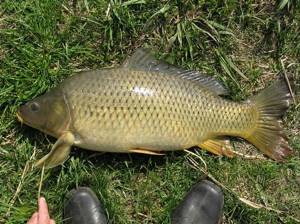
Mirror carp
This species differs from the previous one in that its body is covered with larger scales, which are located along the dorsal fin. Also, mirror carp is more picky in its diet, especially liking shellfish and cereals. It lives mainly in shallow water, but in case of danger it runs into the depths.
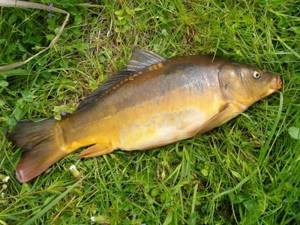
Carp naked
This carp fully lives up to its name, as it has no scales at all. However, in some individuals you can find individual scales in the tail area, near the gills and dorsal fins.
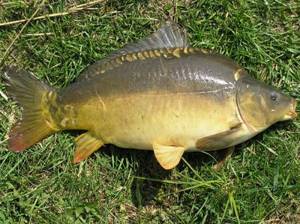
Description
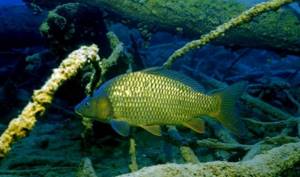
Carp (lat. Cyprinus carpio carpio) is a domesticated form of carp, a fish of the carp family. It was bred in monasteries through selection back in the 12th–14th centuries. Carp are well adapted to life in shallow, well-warmed, stagnant or low-flowing reservoirs located in different climatic zones.
Carp is one of the most common breeding objects in ponds, cages, pools and canals. Its favorite food is bottom organisms: worms and mollusks. Carp can be grown with other fish farming objects that are not competitors for food. Unlike carp - its ancestor, now living in rivers and lakes, carp is a fattening fish, more fleshy, grows faster, but has a less active search ability.
Under favorable living conditions in ponds, carp fingerlings reach a weight of 25-30 g (4-5 pcs./m2), in the south with the same planting density - up to 300 g, two-year-old carp 500-700 g (25 pcs. per 10 m2), three-year-olds 1.5 kg (1 piece/m2). Adjustments must be made for survival. 20-30% of yearlings survive from larvae, 85% of two-year-olds survive from yearlings, and 95% of three-year-olds survive from two-year-olds. The body of the carp is covered with smooth golden-brown scales. The carp's scales are large and have a darkish part around their circumference. There are 35-40 scales on each side of the carp. The back is dark in color.
The carp has a head, body, tail, and fins. The part of the carp's body between the gills and the anus is called the trunk. The part of the body from the anus to the end of the body is called the tail. The head is relatively large. Well developed mouth and teeth. There are two pairs of short mustaches on the upper lip. The carp has fins on its body: dorsal and anal. The sides of the carp are golden.
Carp has pectoral and pelvic fins (paired), which help it move vertically and horizontally in the water. There are other fins - dorsal and anal. They regulate balance. But the tail fin is used for speed. The lifespan of carp is considerable. Some individuals live up to 45-50 years. The weight of an average carp reaches 8-9 kg. Fish live in water at a temperature not lower than 8 °C.
Carp breeding
After the end of wintering, when the water warms up to 10 degrees, sexually mature 3-5 year old carp go to spawn, for which relatively shallow and overgrown areas are selected. Since there are not so many such areas, they are used many times, and each female is fertilized not by one, but by three to five males.
An interesting fact: the age of a carp is a necessary but not sufficient condition for its ability to reproduce; here, as they say, size also matters. So the body length of a male carp should be at least 29 cm, while the female should be even larger, at least 35 cm.

Carp behavior after spawning
After the end of spawning, the carp gradually leaves the spawning grounds and takes up its usual habitats. At this time, he begins to actively feed, restoring strength after spawning. Usually the bite begins in May. At this time, it is caught using a float rod using grains of corn, peas, bread pellets, a worm and many other baits.
In deep areas it is better to use bottom fishing rods. Feeder gear will also perform well when fishing for scaly lumps
When summer comes into its own and the water warms up to the maximum, the intensity of the bite decreases. If water blooms are observed in a reservoir, then it may stop feeding altogether. On hot, sunny days, carp often stand at the very surface of the water. At this time, it is easy to detect with the help of polarized glasses. Polarized glasses differ from regular sunglasses in that they eliminate glare coming from the surface of the water. Thanks to this, the angler gets the opportunity to look several tens of centimeters deep into the water.
Recommended reading: How to catch a large crucian carp
If you find a carp standing at the surface of the water, you can try to catch it using a rig with a water ball. The water ball allows you to apply the nozzle on the surface itself. When fishing like this, it is best to use a regular crust of bread as bait. It is quite natural that if you add an attractant, the number of bites will increase. This fish loves fruity and sweet aromas.
With a gradual decrease in water temperature, carp become more active. In autumn there is generally a peak bite. At least until the water temperature dropped below 10 degrees. After reaching this mark, the pace of life of the fish begins to slowly decrease. This phenomenon is easy to explain. When the weather cools in autumn, fish sense the approach of winter. Of course, he is trying to prepare for winter as best as possible. This explains the strong surge in biting.
Carp fishing
Since carp is a fish that is as strong as it is cautious, to successfully catch it you need to know many nuances, such as:
The best time for carp fishing is spring, as the fish, hungry over the winter, begin to become active. Especially after spawning, hungry fish, losing their inherent caution, will grab almost any bait. However, you can catch carp at other times of the year, but the result may not be as effective, especially when the weather changes, the carp can hide at the bottom and you cannot expect a good catch.
How fast does carp grow?
This “pig” has an incredibly fast growth rate, which is why it is extremely popular as a breeding target. At one year of age, the fish are 15 - 20 cm long and weigh 200 - 300 grams. By the third year of life, the body length reaches 30 - 45 cm with a weight of one to two kilograms. An eight-year-old carp weighs more than 6 kg. In general, it lives up to 50 years and grows to a length of more than one meter. The weight of the fish reaches 30 kg. However, specimens that are too large are not suitable for consumption due to their age. Their meat is tasteless.
We recommend reading: Fishing for carp: how to properly catch carp in a pond and on a river
The structure of the carp digestive system
The digestive system of carp is similar to the structure of other stomachless fish. First of all, representatives of cyprinids are characterized by the absence of teeth on their jaws. They have only pharyngeal teeth, opposite which there is a horny millstone on the palate. With the help of pharyngeal teeth and a millstone, the process of grinding or squeezing food occurs before it passes from the pharynx to the esophagus. Due to the absence of a stomach in carp, food passes directly from the esophagus into the small intestine, where the process of digestion begins. The anterior part of the intestine includes the liver and pancreatic ducts, which are the main digestive organs of the carp.
The pancreas will secrete erypsin and activated trypsin - enzymes that break down food in an alkaline environment. Thus, under the influence of these enzymes, protein foods are broken down into amino acids, which are well absorbed in the intestines.
It should be noted that carp does not produce hydrochloric acid and pepsin.
The carp’s pancreas also secretes stepsin, an enzyme that breaks down fatty acids and glycerol. Of great importance is the bile produced by the liver, which contains taurocholic and cholic acids. Thanks to them, bile has an emulsifying effect on fats, activates lipase and causes stimulation of intestinal motor function. The liver also participates in carbohydrate, protein and vitamin metabolism. The barrier function of the liver is also important, which consists in neutralizing various toxic substances that enter the intestines along with food.
Digestion of food in carp occurs throughout the intestine, and digestion products are absorbed only in the anterior and middle sections.
The cost of feeding carp can be compared with the cost of other farm animals, for example, keeping pigs, which are highly productive animals. The fact is that the energy entering the carp’s body along with food is not spent on maintaining a constant body temperature of the fish.
The basis for a sharp increase in the yield of fish from one unit of area of a reservoir during feeding is the principle that the number of fish planted for cultivation increases, while the characteristics of individual growth remain the same.
Nutrition of carp and carp
Carps feed on everything that is in reservoirs, like their land-based counterparts - pigs. These are reed shoots, water lilies, cattails, pondweed and other aquatic vegetation. Carp will not refuse someone's caviar, no matter whether it is fish caviar or frog caviar. In the summer, carps fill their bellies with underwater insects, snails, worms, leeches, and molting crayfish, and the same egg capsules are used as a garnish. Shellfish are also on the menu of these underwater sybarites. These are: zebra mussels, pond snails, small pearl barley.
Closer to winter, carp and carp begin to fatten up before difficult times, eating all living creatures, including invertebrates.
Small carp fry, two weeks old, find and eat mosquito larvae and various tiny insects, which are still too tough for babies.
